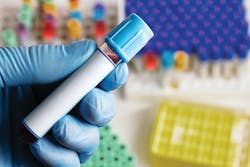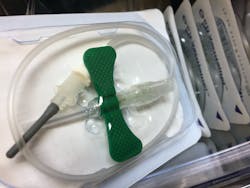Supplies are precious commodities in the lab, and during the COVID-19 pandemic, conservation has become key, inspiring some labs to come up with creative ways to conserve their supplies. Taking the time to do things right — not rushing, which often leads to errors, can be the first step to preventing waste. Be aware of ordering. Fight the urge to overorder, as expired products are still a waste, and forecast anticipated supply use, taking the big picture into consideration when ordering.
Preventing common mistakes
During supply shortages, labs must try to conserve their supplies as much as possible. Preventing waste is one of the easiest proactive steps labs can take to ensure their supplies are there when needed, and taking a few steps extra to be proactive ahead of time can help with these efforts.
Take the time to do things right, as rushing can be costly. Open vacuum seals slowly, ensure pipettes are over a tube before releasing, spin the centrifuge at the right speed, fill tubes to the proper level, take time to follow protocol, and simply be aware of surroundings to prevent bumping into things or getting a lab coat caught brushing past something.
Prioritizing supply use for conservation
The lab prioritizes supply use for those with greatest need, Geddes shared, “There’s a shortage of the 1.8 draws and other blues. We’ve been reserving them for our tertiary care center and our children’s hospital where they really need the lower draw.”
They had to use alternative types of needles, as needles have also been a supply issue. “There’s been a lot of waiting, so we’ve been evaluating. The shortage occurred primarily when across the nation, vaccination clinics started popping up. The one-inch blood draw was being used for vaccines, so there were none available. We’ve had to work with one and half inch, which is a bit longer, and it’s easier to go through veins. There was a bit of a learning curve adapting, but that has been lightening up a little bit. One-inch needles are coming back in now, but that’s been ongoing over a year.”
They looked at four different manufacturers, but nobody had one-inch needles for blood draw readily available, inspiring the changeover to the longer needles for blood draws. “There were some not marketed for blood draw. Not many needles are researched for blood draw; there’s more for injection.”
Creating a tracking system for supply use
To ensure supply, part of their strategy involved finding a couple of different distributors and developing a good process to keep needles in stock. They manually created their own tracking system within their seven-hospital system, showing the use in each lab location and overall totals.
Geddes is not only a lab supervisor at the regional hospital, but a system quality team member. The quality team meets to create daily backorder lists, communicating directly with each other and materials management to prepare for stock shortages, alerting all sites to any potential delays. “There’s a lot less of people not knowing, so this helps prepare staff for any changes coming. That’s also connected us a little closer to the distributor as well.”
Monitoring how many days’ worth of supply the lab has on hand, team members track the expiration dates, making sure they can easily use the stock before expiration. Additionally, they monitor test volumes for utilization purposes. A test utilization committee looks at test appropriateness, volumes and includes staff member input if anyone suspects overuse of supplies. Claims are researched on a case-by-case basis.
“If someone is overusing a certain supply, we try to educate the employee to clarify the appropriate way to do things. There’s some variation with training at different places they’ve worked. Just a little reminder seems to have definitely decreased waste,” Geddes noted.
Paying attention to supply use within the lab can reveal usage issues.
Before the pandemic, Geddes noticed a high use of butterflies in her lab. “Butterflies are variable by site, but here at my site, we moved the location of them into the main office. There’s still open access, but just the fact they’re not in the supply room, we decreased (usage): instead of a box a week, it’s down to a box every two months. There’s no formal sign out or limit, but just that notion of going to a different spot seems to definitely help.”
Even when a forecasting system is created, there can be unforeseen circumstances and opportunities for improvement, Geddes said, “When we forecast out, we base it on standard receiving, but there’s been times where it suddenly took a couple extra weeks. On the reagent side, we had issues. A kit will expire sooner than expected, and we noticed we did not have a separate area to track expiration dates. So, we improved our process for that and for products with short outdates.”
Green measures for supply use
Even before the pandemic, ProMedica had transitioned to using washable lab coats and other green measures.
In 1990, Congress passed the Pollution Prevention Act (PPA) with management approaches to minimize waste and preference for those providing the greatest environmental protection. The American Chemical Society1 cautions not to overorder hazardous materials to minimize any risk and reduce the cost of hazardous waste disposal. Labs may substitute some hazardous materials when less or nonhazardous materials are available, such as using less hazardous glass cleaning chemicals, extraction solvents and reagents.1
Proactively conserving reagents
Proactive steps to conserve reagents can include something as simple as taking time to make sure the right reagent is used and dissolved properly to help prevent errors and waste. Simply holding a sample up to a light to make sure reagent particles are dissolved is an easy waste prevention measure.
During the pandemic, some reagents have been in short supply, and unfortunately, facilities have run low in some products, and ProMedica is one of those facilities. “In those cases where we temporarily don’t perform those tests, they are offered as a send out to a reference lab. We do have a couple right now that we’re just not offering because we do not have the collection containers. Those have specific requirements for one tube type and cannot validate another tube type,” Geddes added.
Kannan spoke of the advantages that technology has created, noting how companies used reagents and automated capping technology in the development the mRNA COVID-19 vaccines to generate highly functional mRNA molecules.
Providing not only higher amounts of mRNA per volume of an IVT reaction, but also a much higher fraction of the functional mRNA molecules, this enables automated solutions for mRNA production with higher throughput capability, generating higher yields of mostly functional mRNA molecules that can be used for downstream applications.
Of course, even with automated systems, there can still be errors. Make sure your equipment is hooked up properly. This sounds like an obvious one, but cords plugged into the wrong area, or not plugged in at all, can waste time and samples. Ensure cords are tucked away neatly, so they do not create a tripping hazard in the lab.
Make sure things are labeled properly, as being in a hurry, it is easy to forget a patient identifier, and if a sample is being sent out, that sample might not get processed due to a simple mistake.
Always make sure not to confuse which sample is which. Double check orders before placing them to make sure there are no errors and the right products are listed, as order mistakes cost time and money, especially during times of shortages.
Forecasting supply delays
Since the COVID-19 restrictions prevent medical devices from being shared with too many people, this has resulted in an increase in demand for portable healthcare equipment.
Amidst the pandemic, demand for laboratory supplies surged, along with the urgency for more complex testing with molecular diagnostics, driving laboratory automation into popularity. More labs are turning to Next Generation Sequencing (NGS) for advanced oncology diagnostics, and the launch of a recent cell painting kit for imaging with microplates expands reagent portfolios. As researchers develop new therapeutics, this demand does not seem to be slowing, Nath Jha explained.
The future of the laboratory supplies market appears to strong, as Nath Jha said the global laboratory equipment and supplies market is vast and is anticipated to generate revenue worth more than $30 billion, with 1.8 times higher spending on lab equipment in 2021 in comparison to pre-COVID years. “The interesting thing about this so far dormant sector is its growth. Across all potential market, we project the growth to remain over 6%, which is enough for catch the eyes of all big players in this business.”
A variety of medical equipment has been in demand, especially with the pandemic inspiring new lab testing, increased diagnostics, and resulting in shortages. Specifically, Nath Jha mentioned, “Legacy equipment, such as incubators, centrifuges, and laminar air flow, will continue to gain in replacement sales category. However, lab air filtration systems have witnessed the new dawn, as most of the big laboratories that did not have this system installed are going for it.”
REFERENCES
- Less is better. American Chemical Society. https://www.acs.org/content/dam/acsorg/about/governance/committees/chemicalsafety/publications/less-is-better.pdf. Published 2002. Accessed July 29, 2021.
- Fact.MR – Rising demand for monitoring wireless portable medical devices to spur the wireless portable medical devices market growth. Fact.MR, Market Research Company. https://www.factmr.com/report/wireless-portable-medical-devices-market. Accessed July 27, 2021.
- Fact.MR – Lab automation market, forecast, trend, analysis & competition tracking - global market insights 2021 TO 2031. Fact.MR, Market Research Company. https://www.factmr.com/report/lab-automation-market. Accessed July 27, 2021.
- Fact.MR – Versatility of micro motors to bolster the sales of micro motors on assessment of technology type during 2021 TO 2031. Fact.MR, Market Research Company. https://www.factmr.com/report/95/micro-motor-market. Accessed July 27, 2021.
- Fact.MR – Bioplastic textiles market, forcast, trend, analysis & competition tracking - global market insights 2021 TO 2031. Fact.MR, Market Research Company. https://www.factmr.com/report/bioplastic-textiles-market. Accessed July 27, 2021.
About the Author
Marisa L. Williams
Editor
The author of more than 100 independently published books, Marisa L. Williams earned her Master’s at Johns Hopkins University, while interning on Capitol Hill, doing press and communications for the National Association of Community Health Centers. Creating her own Bachelor of Science degree at the University of Toledo, Williams blended pre-medical, pre-law, and laboratory studies, resulting in an interdisciplinary degree emphasizing Forensics. She has worked with Dr. Paulette Moulton (Levy), a dermatologist in Monroe, MI, as well as Dr. Elizabeth Triana, a family medicine practitioner specializing in hormone therapy, based out of Port Charlotte, FL; additionally, she has 20 years of experience as a multimedia journalist, is a third generation Realtor licensed in MI and FL, and has five years of college level teaching experience.





